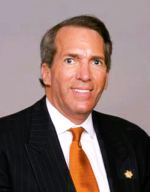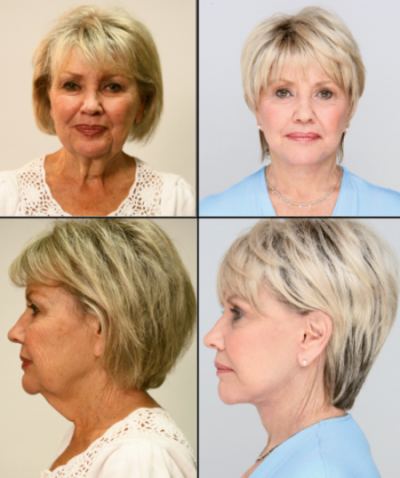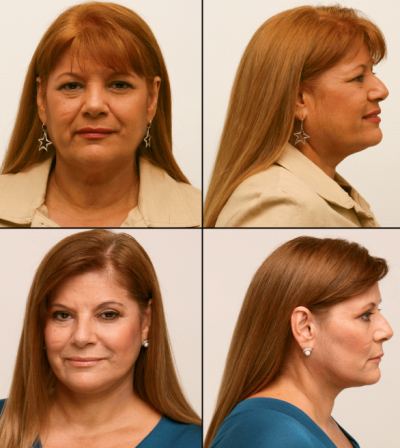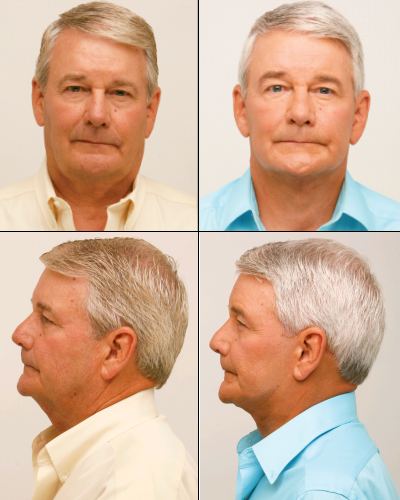
Malcolm D. Paul, MD

Before and after LSL plus neck-firming procedure.
The introduction of the Lifestyle Lift (LSL) business model has had a revolutionary impact on the facial plastic surgery market. By mastering an approach that is safer and more affordable, and allows for faster recovery, LSL greatly expanded the available market for facial plastic surgery, opening it to tens of millions of people who never considered the fact that facial plastic surgery might be right for them.
Not unexpectedly, the traditional plastic surgery community resisted these efforts, often by making misleading public statements or anonymously filing complaints, targeting our advertising, doctors, marketing and business practices, and integrity.
LSL has and will continue to aggressively defend and protect its brand name and the reputation of its doctors. LSL has a remarkably low medical malpractice litigation experience, especially considering that more than 25,000 LSL procedures are performed each year. The company has successfully litigated suits filed against a national competitor who disparaged our brand name, as well as against NBC Universal for defamation.
For activities prior to 2008, LSL reached a settlement with the State of New York concerning attempts to provide fake positive consumer reviews. And while there is an open inquiry pending in Florida, the company has been fully cooperating with the Attorney General’s office and is quite confident that the outcome will not involve a penalty or fine.
Nonetheless, in the early days, we took these attacks personally and reacted in a very aggressive manner.
But that was then.
For the last several years, we have opened our doors to allow any doctor to come and learn the truth about what we do and how we do it. Fully 90% of those who visit us and learn about the LSL express an interest in participating.
WHAT IS THE LSL?
The original LSL procedure was a short scar facelift with superficial musculoaponeurotic system (SMAS) plication performed under local anesthesia and oral sedation. It became obvious to David Kent, DO, the founder of the LSL Company, that there was enormous potential for this procedure in the manner in which it was performed. Additionally, variations of the short scar facelift with SMAS plication had been used safely for 30+ years.
All procedures are performed under Level 1 Anesthesia (oral sedation and local anesthesia) with monitoring available. Although all surgeons have complete discretion as to the exact technique utilized, the basic LSL procedure typically includes standard facelift-length incisions along with SMAS plication, SMASectomy, or a SMAS flap dissection. The central neck is approached on a case-by-case basis.
Surgeons have the latitude to do as much as they feel is necessary, including energy-based or traditional liposuction for removal of fat and tissue tightening, platysmaplasty, or a corset platysmaplasty to achieve an optimal neck contour. The approach is individualized to the anatomy and desires of each patient. We also offer upper- and lower-lid blepharoplasty, brow lifting, fractional CO2 laser resurfacing, fat transfer, and chin augmentation.
Patients typically go home or to a local hotel with an appropriate caregiver after the surgery. They are seen the next day, often the second day, and then at 1 week, 1 month, and 3 months postoperatively, although the exact follow-up schedule is left to the discretion of each physician.
THE LSL BUSINESS MODEL: WHY IT WORKS

Before and after LSL plus neck-firming procedure.
From the opening of an initial center in 2002, to more than 58 locations today, the next 2 years will see LSL have a presence in more than 100 cities across the US. The success of this organization piqued my interest, and I wanted to learn more about the LSL business model—something that could only be educationally and scientifically fulfilled by being on the inside looking out rather than on the outside looking in. I saw enormous potential, and I am now actively contributing to the organization’s goal of continually improving the experience for patients and for the physicians at LSL.
A business model was developed in which surgeons could concentrate on performing surgery, avoiding the emotionally and financially challenging issues inherent in a private practice.
Concentrating on what we do and how we do it is similar to the Nordstrom pyramid. In summary, Nordstrom customers and LSL patients are at the top of the pyramid while corporate leadership is at the bottom. This is why Nordstrom and LSL have been, and continue to be, so successful.
This is not well understood and certainly does not represent mainstream belief among non-LSL surgeons. The business model places strong emphasis on consumer awareness/patient acquisition and the management of a clinical practice.
Potential patients learn about LSL through mass media advertising. The patients who read about LSL or learn about us through the web, cable TV, or other media outlets are typically not looking for a cosmetic surgeon. Rather, they become educated about what this procedure can offer, and approximately 700,000 potential new patients contact our call center in Troy, Michigan, each year.
Approximately 40% set up an appointment for a free consultation, but only a small fraction of the 700,000 potential patients book a procedure at an LSL center. The benefit to non-LSL surgeons occurs when a potential patient reads or views an advertisement and decides to call a non-LSL surgeon who may have operated on their friends and/or family members. So, the viral marketing effect takes place and non-LSL surgeons benefit from this national multimillion-dollar advertising campaign. It is, therefore, myopic to look at the LSL as only benefiting the LSL surgeons.
The LSL clinical superiority results from hiring top-tier physicians, and having physicians devote all of their time and energy to patients and providing them with a level of support unmatched in private practice.

Before and after LSL plus neck-firming procedure.
First, LSL recruits only from the ranks of plastic surgeons, facial plastic surgeons, and head and neck surgeons. These physicians are board certified or board eligible, and more than half are double board certified. While these are qualifying considerations, if the LSL medical directors do not believe a new physician has enough recent or relevant experience, they will be required to work under a mentor for 1 to 3 months, usually gaining more experience during this time frame than a year-long fellowship program would provide.
Second, with no day-to-day responsibility for managing the practice, LSL surgeons are able to perform significantly more procedures than non-LSL physicians. Consider that 7,000 plastic surgeons performed 113,000 facelifts in 2010, according to 2010 statistics from The American Society of Plastic Surgeons. Seventy physicians at LSL performed 22,000 facelifts in that same period. Proficiency does not occur from performing 100 operations once, but after a surgeon performs one operation 100 or more times. The literature across surgical disciplines is rife with acknowledgment that high surgical volumes are associated with better outcomes and fewer complications.
The third and equally critical element of the LSL approach is not to tell physicians what to do, but rather to provide them a support system. The core of this system is a team of medical directors who are available to support a physician through on-site visits. Moreover, clinical questions and answers may be provided on a secure Web site or over the phone. Depending on their training and experience, physicians new to LSL may be observed by a medical director or another highly experienced LSL physician when they first begin. The medical directors may also periodically review cases and provide physicians with feedback.
Additionally, LSL makes an assortment of resources available to help physicians new to LSL and foster more rapid development of clinical skills for all physicians. For example, the LSL Physician Council created a Clinical Guidelines document to help physicians improve techniques for all aspects of what they do, including lidocaine safety guidelines, best practices for local anesthesia delivery, and control of hypertension. Physicians are encouraged, at LSL’s expense, to visit any other LSL physician to observe and learn how to improve their technique and results. As the organization adopts new procedures or technologies, there is a customized training program conducted on-site for physicians and their support teams. There is also an annual conference sponsored where LSL physicians present various techniques.

Before and after LSL plus neck-firming procedure.
Our Innovation Center in Albuquerque, NM, serves as our “clinical laboratory” for evaluating new practice concepts. Working with our Physician Council and coordinating with other centers, the Innovation Center considers new technologies, new equipment, new procedures, and other new ideas to determine if they have merit. The Innovation Center often acts as an “alpha” site evaluating these new concepts, after which they are trialed at “beta” sites. This more rigorous evaluation process provides the Physician Council with greater confidence to determine what is to be added to our practice to better serve our patients.
Over the last several years the Innovation Center has engaged with more than 30 vendors offering such products and services as energy-based ablative skin resurfacing, energy-based soft tissue remodeling, amniotic membrane with inherent growth factors to aid wound healing, fat injections (incorporating state-of-the-art technology to improve graft removal, preparation, and survival), barbed sutures, silastic chin augmentation, and lateral limited incision brow lifting.
LSL has practice-management guidelines that are continuously being upgraded and, although accreditation of LSL centers is not required, accreditation by Accreditation Association for Ambulatory Health Care (AAAHC) has been obtained in several LSL centers and is in the process of being implemented nationally.
THE LSL PATIENT EXPERIENCE
I can definitively say that I have never seen an emphasis on the patient experience comparable to the LSL EPIC (Every Patient Interaction Counts) program. Working with an outside consulting firm, LSL has spent millions of dollars and devoted considerable resources to understanding the emotional needs of patients and then training every member of the team—from the front desk to the physician—on how to provide the best experience for the patient. When patients are first seen at a LSL center, consultants discuss what we do and share pricing and practice information.
Comprehensive medical history questions are asked and, when indicated, medical clearance is obtained through an appropriate specialist or a primary care physician. Contrary to some beliefs among non-LSL surgeons, we do see our patients pre- and postoperatively, and we are available through a national call center 24/7 to answer questions and address concerns. Just as importantly, our EPIC program provides psychological support to patients throughout the process from initial consultation to the postoperative period. When indicated, revision procedures are performed at minimal or no cost to the patient by the original surgeon or by another LSL surgeon.
The organization regularly conducts confidential patient-satisfaction surveys. This data is used to improve both results and the patient experience. In fact, both the patient experience and clinical quality are of such importance that an element of the physician’s compensation is based on each physician’s overall patient-satisfaction survey results. Coaching on areas of low satisfaction scores are routinely offered to physiciansCosmetic surgeons can just read the headlines or take it from someone who knows and understands the ins-and-outs of the LSL business model and procedures. I personally have firsthand knowledge of “who” the company is today, and that is why I elected to become a part of LSL.
Malcolm D. Paul, MD, is a Newport Beach, Calif-based plastic surgeon. He is board certified by the American Board of Plastic Surgery and a fellow of the American College of Surgeons. Paul is a clinical professor of surgery at the Aesthetic and Plastic Surgery Institute at the University of California, Irvine. He is the past president of the American Society for Aesthetic Plastic Surgery, the California Society of Plastic Surgeons, and the Orange County Society of Plastic Surgeons. Paul is also past chairman of the Board of Trustees of The American Society of Plastic Surgeons. He is a consultant to Lifestyle Lift. Paul can be reached at [email protected].


